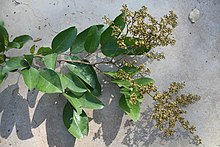Dialium guineense
| Dialium guineense | |
|---|---|

| |
| Scientific classification | |
| Kingdom: | Plantae |
| Clade: | Tracheophytes |
| Clade: | Angiosperms |
| Clade: | Eudicots |
| Clade: | Rosids |
| Order: | Fabales |
| Family: | Fabaceae |
| Genus: | Dialium |
| Species: | D. guineense
|
| Binomial name | |
| Dialium guineense | |
| Synonyms[2] | |
| |
Dialium guineense, the velvet tamarind,[3] is a tall, tropical, fruit-bearing tree in the family Fabaceae. It has small, typically grape-sized, edible fruits with brown, hard, inedible shells.
Distribution and habitat[edit]
Dialium guineense is native to West Africa, from Senegal east to the Democratic Republic of the Congo.[1] It grows in dense forests along the southern edge of the Sahel.
Uses[edit]
The bark and leaves have medicinal properties and are used against several diseases.[citation needed]

Fruit[edit]
Each fruit typically has one hard, flat, round, brown seed, typically 7-8 millimeters across and 3 millimeters thick. The seed somewhat resembles a watermelon seed (Citrullus lanatus). Some have two seeds. The seeds are shiny, coated with a thin layer of starch.
The pulp is edible and may be eaten raw or soaked in water and consumed as a beverage. The bitter leaves are ingredients in a Ghanaian dish called domoda.

Timber[edit]
Wood is hard and heavy and used for construction. The wood is also used for firewood and charcoal production
References[edit]
- ^ a b IUCN SSC Global Tree Specialist Group & Botanic Gardens Conservation International (BGCI) (2022). "Dialium guineense". IUCN Red List of Threatened Species. 2022: e.T204813231A204813233. Retrieved 16 January 2023.
- ^ a b "Dialium guineense". Plants of the World Online. Royal Botanic Gardens, Kew. Retrieved 22 April 2024.
- ^ "Dialium guineense". European and Mediterranean Plant Protection Organization (EPPO). Retrieved 22 April 2024.
External links[edit]
- World Agroforestry
- Dressler, S.; Schmidt, M. & Zizka, G. (2014). "Dialium guineense". African plants – a Photo Guide. Frankfurt/Main: Forschungsinstitut Senckenberg.
 Media related to Dialium guineense at Wikimedia Commons
Media related to Dialium guineense at Wikimedia Commons Data related to Dialium guineense at Wikispecies
Data related to Dialium guineense at Wikispecies

